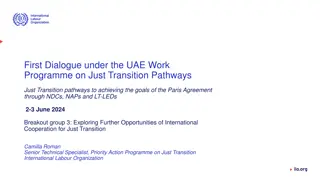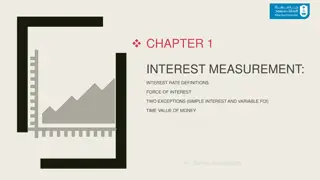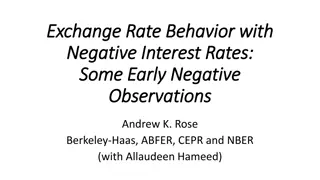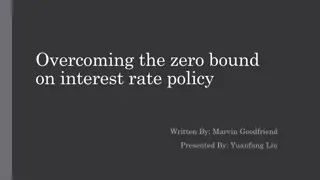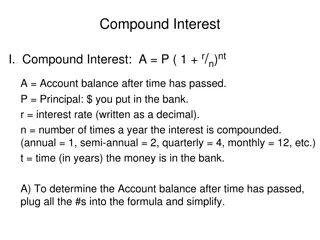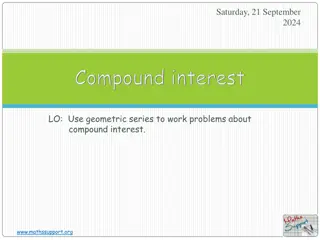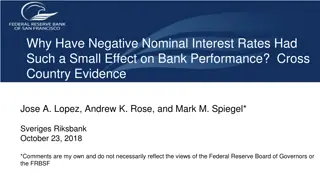
Impact of Transition to Low Interest Rate Environment on Insurers - Insights from India Fellowship Seminar 2016
Explore the implications of transitioning to a low interest rate environment on insurers, as discussed in the India Fellowship Seminar June 2016. Delve into the effects on long-term liabilities management, income, valuation, and product impact. Gain insights into the causes of low interest rates and how insurers can navigate these challenges effectively.
Download Presentation

Please find below an Image/Link to download the presentation.
The content on the website is provided AS IS for your information and personal use only. It may not be sold, licensed, or shared on other websites without obtaining consent from the author. If you encounter any issues during the download, it is possible that the publisher has removed the file from their server.
You are allowed to download the files provided on this website for personal or commercial use, subject to the condition that they are used lawfully. All files are the property of their respective owners.
The content on the website is provided AS IS for your information and personal use only. It may not be sold, licensed, or shared on other websites without obtaining consent from the author.
E N D
Presentation Transcript
India Fellowship Seminar June 2016 Transition to a low interest rate environment Impact on long term liabilities management Guide Richard W Holloway Presenters Prerna Nagpal Himanshu Garg 9th June 2016 Mumbai, India Indian Actuarial Profession Serving the Cause of Public Interest
Contents Impact of low interest environment on Insurers Insurance Industry Response & Solutions Indian Market Regulations and Practice Standards Conclusion Multiple Choice Questions www.actuariesindia.org 2
Impact of Low Interest environment on Insurers Are Low (or negative) Interest Rates even possible ? Cause of Low Interest Rates Impact of low Interest Rates on Income and Valuation Assessment of Impact at Product level www.actuariesindia.org 3
Are Low (Negative) Interest Rates possible? Official Policy Rates in Major Economies www.actuariesindia.org 4
Causes of Low Interest Rates Drivers for decline in long term risk free real interest rates over past two decades Demographic pressure associated with increased longevity Gradual integration of China into global financial markets with pattern of capital flowing uphill from emerging to advanced economies. Decline in propensity to invest played a role in explaining developments since 2008. Shifts in the supply of, and demand for, safe assets, particularly since the financial crisis. This is consistent with the rise in equity risk premium in recent years. www.actuariesindia.org 5
Impact of Low Interest Rate on Income and Valuation Impact is mainly in two ways: a. Income Channel (Impact on profitability) Lower Reinvestment income as fixed income securities are re-invested at lower rates. 1 a. Balance Sheet Channel (Impact on Solvency) decrease in interest rates increases values of both assets and liabilities. In Solvency II there is higher increase in value of liabilities because duration of liabilities is much longer than assets (average duration of government bonds in EIOPA stress test was 8.6 years!). Further, magnitude of assets invested in fixed income securities is lower than total liabilities. Profitability impact takes time whereas Solvency impact is immediate. 2 www.actuariesindia.org 6
Product wise Impact PRODUCT IMPACT ALM Mismatch leading to Reinvestment Risk Guaranteed Maturity Benefits > Asset Shares Guaranteed Surrender Benefits > Asset Shares Significant balance sheet strain High hedging costs Lapsation may increase Options built in policy may be exercised by policyholders NON PARTICIPATING Lack of long duration assets to match hence high Asset Liability Mismatch leading to Reinvestment Risk High Hedging costs Insurer may be unable to meet liabilities Reinsurance for Term policy may reduce the impact ANNUITIES AND TERM www.actuariesindia.org 7
Product wise Impact cont.. PRODUCT IMPACT Bonus rates may not be PRE Reinvestment Risk May increase lapsation Value of In built guarantees < Asset Shares PARTICIPATING Not much impacted unless minimum/Guaranteed Sum Insured are high Lower investment returns may reduce marketability UNIT LINKED www.actuariesindia.org 8
Product wise Impact cont.. PRODUCT IMPACT 1 year policy may not be impacted but premium may increase leading to low marketability Long Term Care products may be impacted HEALTH 1 year policy may not be impacted but premium may increase leading to low marketability Long Term Home Policies may be impacted NON LIFE www.actuariesindia.org 9
Market Response and Solutions Insurance Industry Response: Japan A case study of Sub Prime Crisis Assessment of various solutions available a. EIOPA Stress Tests b. Interest Rate Modelling approach C. Product Innovation www.actuariesindia.org 10
A case study on Japan The Japanese life insurance industry offers a real-world example of what can happen when interest rates suddenly decrease and stay low for an extended period of time 8 life insurers were liquidated or taken over between 1997 and 2003. Rapid decline in the interest rate in 1980s induced insurers to invest in stock markets which subsequently also faced downturn when the stock market bubble burst in 1989. Significant losses to insurers in foreign currency holdings in the mid-1980s following a large appreciation of Yen. Insurers continued to offer guarantees in order of 5.5% until mid-1990s amid fierce competition from Government sponsored financial institutions. Loss of policyholder confidence and surge in surrenders www.actuariesindia.org 11
Japan Solutions Implemented Deregulation of product and price; dramatic shift in sales mix Improved financial planning reporting; solvency requirements Gradual implementation of risk management process Staff reductions; hiring freezes; compensation reductions Rationalisation of sales; reduction in sales force size Growth of new distribution channels Insolvency and restructuring of weaker players Gradual reduction in balance sheet risk Dramatic growth of well managed new entrants www.actuariesindia.org 12
A Recent Example: Subprime Crisis Expansionary fiscal policy- tax cuts for every income bracket in US Increased spending on war in Iraq and Afghanistan US Government s Debt/GDP ratio reduced from less than 58% in 2001, to 65% in 2005, to nearly 70% in 2009. Fiscal Loose monetary policy in the aftermath of the collapse of dot-com bubble By the end of 2001, Fed rates lowered by 2% Monetary Lax financial supervision Regulatory and legislative changes made it easier for firms and households to take on increased debt loads and encouraged more subprime lending. Regulatory + Supervisory www.actuariesindia.org 13
Impact of first QE announced in 2008 in US Impact of QE on US Banks o Margin Pressure funding cost decline was more than offset by fall in securities yields. Banks NIMs were pressured and profitability impacted. o Lower Volatility By reducing volatility, QE impacted investment banks securities trading operations oQE related Deposits Institutional investors placed some of the excess liquidity as deposits. Deposit volumes grew and bank liquidity positions improved. oBook value accretion ALM portfolios showed an uplift, owing to unrealized gains www.actuariesindia.org 14
Some Solutions Solution Considerations Interest Rate Derivatives/Swaps Availability, Regulatory constraints Product Diversification Costs, ALM strategy Geographical (outside India) Diversification Regulatory constraints Lower Guarantees in New Products Market sentiments Higher premium for New Policies/Products Popularity, competition Lowering of Bonus rates Comparable products, anti selection Increasing charges on policies Popularity, competition Asset Liability Matching Cost, availability of assets Creation of Industry funded policyholder protection fund Investment in alternate assets Willingness of other players ? Availability, cost constraints Use of Internal Models Regulatory approval Reinsurance Availability, complexity of contracts www.actuariesindia.org 15
EIOPA Stress Test 2014 The low yield module, as developed for the 2014 EIOPA stress test exercise, is a bottom-up stress test exercise implying calculations performed by insurance undertakings aiming at capturing the impact of several low interest rate scenarios. A Japanese-like scenario embodying a persistent low interest rate environment An Inversescenario with an atypical change in the shape of the yield curve Impact on Balance Sheet Impact on Interest Rate Exposure Impact on Profitability SCR, Own funds Asset & Liability Values Durations Cash flow Matching Internal Rates of return www.actuariesindia.org 16
ModelingInterest Rates In the contemporary stochastic modeling approach, there is no possibility of modeling negative interest rates. The dominant core principles of interest rate modeling of the past decades have been that (1) interest rates don t go negative (2) there must be consistency with current bond prices (3) there must be parametric consistency with historical data. There is no history to guide an appropriate contemporary model approach Alternatives Available Discard the log normal modeling approach Model using a normal distribution random walk www.actuariesindia.org 17
Product Innovation www.actuariesindia.org 18
Indian Market Interest Rate Environment in the Indian Economy Risks and Issues www.actuariesindia.org 19
10 Year GoI Yield Movement Interest rates have fallen in India for a long period Current Highest Lowest Dates Unit 7.46 14.76 4.96 1994-2016 percent www.actuariesindia.org 20
Risks and Issues of a low Interest Rate regime Increasing Non-Participating business of Life Insurers 1 Post Regulatory reforms, sale of endowment/term/products will in-built guarantees is increasing as compared to Linked Insurance. Hence, low interest regime will increase hedging costs, reduce marketability of the products and may make valuation of guarantees higher than the asset share. Bonus on Participating business may become unattractive 2 Decreasing interest rates may further lower bonus on participating business which may become unattractive to policyholders / new customers (actual bonus rates may not meet PRE) Increasing ALM Risk 3 Decreasing interest rates combined with absence of long dated fixed income securities, Indian Insurers have high re-investment risks which in case of low interest environment may make Asset Liability Management more challenging. www.actuariesindia.org 21
Risks and Issues of a low Interest Rate regime cont.. Annuities will become further less unmarketable 4 Annuities are still not very popular in Indian market though picking up. Lower interest rates will reduce their marketability and will make asset liability mismatch for Insurers cost prohibitive. Increased Lapsation / Persistency may deteriorate 5 Low interest environment will increase premiums and reduce attractiveness of benefits such as Bonus thus will increase lapsation. Non Life underwriting losses 6 Currently Non Life Insurers are subsidizing underwriting losses from investment surplus, which may not be possible in low interest regime. www.actuariesindia.org 22
Some more Risks and Issues Regulatory Risk Change of existing solvency regime to Risk based solvency 7 Actuaries need to evaluate the implication of interest rates particularly on non participating portfolio and guarantees given under the scenario of solvency regime change to risk based solvency. Stress Tests are current guidelines and practices robust and relevant? 8 Industry can consider merit in evaluating whether current stress tests guidelines are adequate, robust and relevant with changing interest rate environment. www.actuariesindia.org 23
Regulations and Practice Standards www.actuariesindia.org 24
Key Guidance Notes and Practice Standards Relevant Guidance Notes and APS Key Learnings GN 22 Reserving for Guarantees in Life Assurance Business In respect of non participating business the risk of a decline in the interest rate should be duly recognized and a suitable adjustment made. GN 6: Management of Participating life assurance business with reference to distribution of surplus Actuary needs to consider all future interest rate scenarios that can be reasonably be foreseen. GN 29 Valuation of Interest Rate Guarantees on Exempt Provident Funds Actuary must identify and consider the extent, to which falling or rising interest rates may threaten the ability of the office to secure policyholder interests and where such risks cannot be substantially matched or mitigated APS 1: Appointed Actuary and Life Insurance Business APS 2: Additional Guidance for Appointed Actuaries and Other Actuaries involved in Life Insurance APS 3: Financial Condition Report Adequate provisions to be kept for guarantees and embedded options APS 5: Appointed Actuary and Principles of Life Insurance Policy Illustrations Various approaches including stochastic modelling to be used. Margin for adverse deviation to be assessed. APS 7: Appointed Actuary and Principles for determining Margins for Adverse Deviation (MAD) in Life Insurance Liabilities Documentation conclusions used by Actuary of approach, rationale and APS 10: Determination of embedded value of Life insurance companies incorporated in India www.actuariesindia.org 25
IRDA Regulations Relevant IRDA Regulations IRDA (Assets, Liabilities and Solvency Margin of Insurers) Regulations Guidelines on Interest Rate Derivatives Key Considerations Do solvency margins increase for a low interest rate environment? Availability of derivatives, flexibility of regulations? Do they cover changes to policyholder s behaviour? Adequacy and Appropriateness of Interest Rate Risk Management practices? Are they stringent/practical for current market scenario? How strict are the stress test standards? IRDA Protection of Policyholder s Interest Regulation IRDA (Actuarial Report and Abstract) Regulations IRDA (Investment Regulations) Asset Liability Management and Stress Testing Circular Guidelines on Corporate Governance for Insurers in India Do they evolve with changing market scenario? www.actuariesindia.org 26
Conclusion www.actuariesindia.org 27
Some Thoughts Possibility of prolonged low interest rate environment possible in India Need for a risk based solvency framework/product Innovation Assessment of Interest rate risk in actuarial reports Importance of regular Stress testing and ALM Interest Rate Risk specific guidance notes www.actuariesindia.org 28


